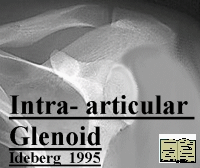Intra-articular glenoid fractures
Classification
 |
IdebergI - Glenoid rim; type IA—anterior and type IB—posterior II - Fossa, with inferior triangular - transverse fracture through the glenoid fragment displaced with the head III - Oblique fracture through the glenoid exiting at the midsuperior border of the scapula, often associated with acromioclavicular fracture or acromioclavicular dislocation IV - Horizontal, exiting through the medial border of the blade V - Combines type IV with a fracture separating the inferior half of the glenoid. VI - Added by Goss, severe comminution of the glenoid surface. |
Look for articular step, displacement and if humeral head well centered in glenoid
Treatment
Ideberg type I
I A Anterior
rim, I B posterior rim.
The main goals of treatment for fractures of the glenoid rim are to maintain
glenohumeral stability and to prevent arthrosis.
Indications for surgery:
-
>10 mm displacement involving more than 25% of the anterior rim or more than 33% of the posterior rim
-
Persistent instability.
Treat with screw fixation with or without capsulolabral repair. If non operative course undertaken need regular clinical and radiological review to pick up early dislocation/ subluxation.
Ideberg type II–V
Patients with
minimal displacement can be managed with functional rehabilitation. When the
humeral head is subluxed or articular displacement is greater than 5 mm, open
reduction and internal fixation should be considered.
MUA seldom improves position alone. Some late improvement can be seen with
conservatively treated fractures.
Type II
Transverse or oblique fracture through the glenoid with the inferior glenoid as
a free fragment. The humeral head may subluxate inferiorly with the glenoid
fragment.
Type III
Involves the upper third of the glenoid and includes the coracoid. ORIF if
articular step > 5 mm.
Intact glenohumeral ligaments may maintain congruity of the fracture fragments,
and early motion may spontaneously improve fracture position. Surgical fixation
is not easy.
Type IV
Horizontal fracture extending through the body. ORIF if articular step.
Type V
Combination of types II and IV. ORIF as above, favouring conservative Rx if humeral head centered.
Type VI (Added by Goss)
Multifragmentary fracture best treated with early motion.
References
Kavanagh, Brian F.. Bradway, John K.. Cofield, Robert
H.. Open Reduction and Internal Fixation of Displaced Intra-Articular Fractures
of the Glenoid Fossa. JBJ - 75-A(4):479-484, April 1993.
LAFOSSE, L. PRIMARY ANTERIOR GLENOID RIM FRACTURE: INDICATION FOR ARTHROSCOPIC
STABILISATION? JBJS -B 81-B Supplement II:134, 1999.
Marra, Guido MD. Stover, Michael MD. Glenoid and scapular body fractures.
Current Opinion in Orthopedics. 10(4):283-288, August 1999